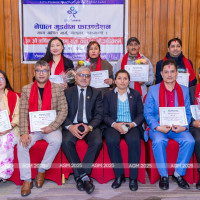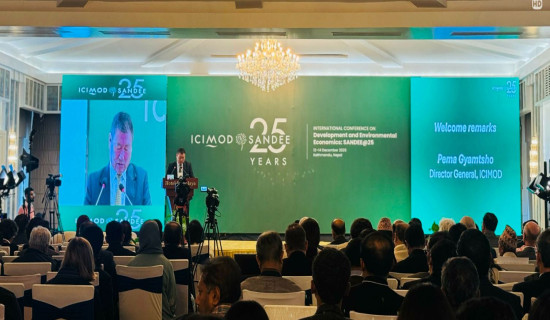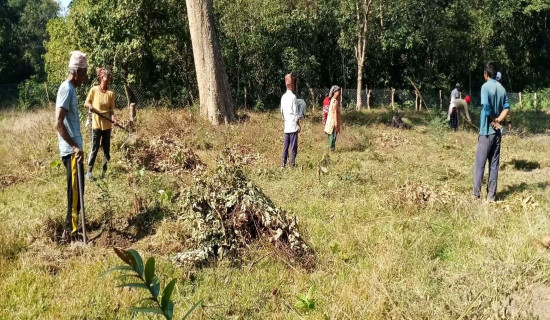- Sunday, 14 December 2025
From Print To Pixels: Future Of News Media
The restoration of democracy in 1990 marked a watershed for Nepal’s mediascape. One of the greatest beneficiaries of this democratic transformation was the news media—one of the pillars of democracy. Nepali media underwent profound changes soon after 1990. Between 1990 and 2005, Nepal witnessed the early stirrings of digital media, although internet penetration remained extremely low. Nepalnews.com pioneered online reporting in 1999, targeting a limited urban audience. Social networking sites had not yet emerged, so digital platforms had minimal influence on the mainstream media.
Internet access expanded rapidly in urban areas and major townships between 2006 and 2012. Cyber cafés multiplied, and individual internet access surged. Multiple online news portals emerged, far faster than print. News and views soon travelled online faster than through traditional outlets. Mainstream newspapers began reallocating resources toward digital editions, forcing print, radio, and television to confront digital media as a serious competitor. The transformation accelerated between 2013 and 2015. Facebook and Twitter (now X) use soared among journalists, politicians, and youth. Falling internet and smartphone costs turned these platforms into the primary sources for breaking news, shifting public debate from newsrooms to Facebook timelines and Twitter threads.
Citizen journalism
This shift fostered citizen journalism, particularly after the 2015 earthquake, when social media outpaced traditional outlets as the fastest and most influential information channel. Social platforms steadily eclipsed traditional media from 2016 onward. By mid-March 2024, 7,997 newspapers and magazines were registered, including 765 dailies, 39 biweeklies, 2,985 weeklies, and 4,208 others, with 5,376 of them in Nepali language. In total, 720 FM radio stations and 105 television stations operated, alongside 1,672 active online news portals. Online portals became the main source of daily news, especially for youth. Facebook and YouTube emerged as central spaces for news, entertainment, and political narratives, while TikTok reshaped content consumption further.
Print circulation declined sharply, digital advertising grew, and digital-first journalism became the industry standard. Prominent magazines stopped printing; Nepali and English dailies continue to struggle. Radio and television face a similar fate, while online portals—low-cost and unconstrained by space—integrate the functions of radio, TV, and print. Smartphones and rising internet penetration transformed how people consume information, but the shift brought challenges: misinformation, disinformation, infodemics, weak digital regulation, sustainability concerns for traditional media, and ownership concentration.
Against this backdrop, the Federation of Nepali Journalists (FNJ) on 14 November 2025, organised an interaction on journalists’ safety, accountability, and sustainability. Participants emphasised strict adherence to the Code of Conduct (CoC), rethinking mainstream journalism, and embracing new technologies. Traditional media faces challenges threatening its survival. Online platforms operate like radio, TV, and print, with unlimited content space. Platforms such as Facebook, X, TikTok, and YouTube disseminate information faster than traditional outlets. Audiences increasingly prioritise immediacy over accuracy, gravitating toward platforms that offer fresher updates, often regardless of authenticity.
Accessibility has transformed the information ecosystem. Anyone with a smartphone and internet can consume, share, and produce content. Traditional media remain largely one-directional, offering little room for audience engagement, whereas social platforms provide interactive spaces for users to respond, react, and influence public discourse. Citizen journalism is another defining development. Individuals can create content and react instantly to events of personal or public concern, giving people a platform to voice long-suppressed views, often ignoring consequences.
Media consumers’ inability to differentiate social platforms from news media has become a major problem, even among educated audiences, leading to confusion over credibility, standards, and journalistic responsibility. Another contributor to trust erosion is the overt political affiliation of many journalists and their organisations. Nepal has as many journalist associations as political forces, resulting in biased reporting and alienating audiences seeking impartiality.
Environmental concerns have also affected print media. Younger generations—particularly Gen Z—prefer digital content for accessibility and readability, while the global push to reduce paper consumption further discourages print, which depends heavily on newsprint derived from trees. Literacy, affordability, and availability continue to shape media consumption. Many older adults cannot read, younger audiences rarely do, and print editions are costly and unavailable in remote areas, driving people toward handheld devices.
Safeguarding journalism must begin with depoliticisation. Individual journalists may hold personal political beliefs, but newsrooms must remain independent. The practice of forming journalist organisations as political wings and political parties nominating FNJ candidates must end. Rising attacks on journalists largely stem from CoC violations and weak accountability, damaging credibility and reinforcing perceptions of political bias. Strict adherence to the CoC is inevitable.
Traditional media have fallen into churnalism—recycling online content instead of producing original reporting—which must be abandoned. A 2023 media survey revealed troubling indicators: 63 per cent of informants said media is not accountable, 47 per cent found citizen participation meaningless, 70 per cent said media houses do not invest in capacity building, 44 per cent believed press freedom has been encroached upon, and 45 per cent saw no collaboration among stakeholders to promote free, accountable media.
Digital literacy
Nationwide digital literacy programmes are essential for both journalists and media consumers. Without the ability to distinguish news media from social sites, the crisis will deepen. Bridging the gap between journalists and the public is equally crucial. Misunderstanding and mistrust have fuelled conflicts, character assassination, intimidation, and attacks on journalists.
Initiatives like FNJ’s Free Media Network, which brings together stakeholders to discuss issues emanated from news reporting, are timely. Journalists must also prepare themselves to adapt to technological change. Media institutions and CSOs should prioritise training in the emerging areas such as fact-checking, verification tools, and digital literacy and security. The strongest path to survival for traditional media lies in a renewed focus on investigative journalism. Audiences will not wait 12 hours for information that is available instantly on social networks. Traditional media remain relevant only by offering depth, context, and original revelations.
(Sedhai is a freelance writer.)
















